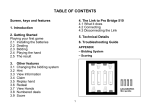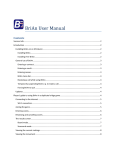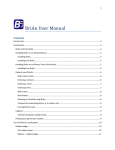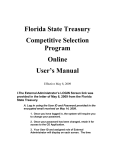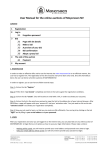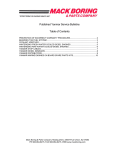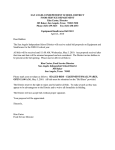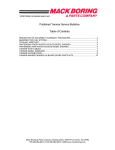Download Pianola User Guide for Players
Transcript
Pianola User Guide for Players How to analyse your results, replay hands and find partners with Pianola Pianola is used by the American Contract Bridge League, the English Bridge Union, and clubs large and small around the world. Contents Introduction How to login How Pianola Works Compare Pianola and Pianola Plus Pianola Results Pianola Plus Results Bidding accuracy Card play Session report Interpreting the charts Summary table Pianola Replay Competitions Members Partner Finder Other options My account “I finished classes two years ago having retired. I love bridge just wish I had started years ago! Obviously I have so much to learn. Before Pianola, I used to bring home the print-out of all the hands and examine them for where I bid wrong or how could I have played better. I would make up the hands manually so I could replay them. Now, Pianola gives me all the stats - how well or badly I bid, best defensive leads and card play. I can also look and examine each hand and replay .” Edna Paterson, Player, Glasgow Bridge Centre “Pianola is a great addition to the club. Our players really benefit from the information it provides.” Andrew Robson, Writer, Teacher, and owner of the Andrew Robson Bridge Club Introduction Pianola was created for you, the bridge player. It’s a set of tools that allows you to view your bridge results in new and innovative ways. It can also show you analysis of your play and trends over time. Pianola also helps you find partners and has numerous other features. Pianola gives you a personal history of your own results with your average score over time, and with each of the different partners with whom you play. We also calculate your average on all the boards where you were declarer, dummy, defender-onlead and defender-not-on-lead and show you these statistics as an average over time and on a game-by-game basis. By subscribing to Pianola Plus, an optional upgrade, you get analysis of your bidding accuracy and card play ability. When you’re a Pianola Plus subscriber you can also play hands again with cardby-card guidance about how to achieve the most tricks possible. Thank you for using Pianola. If you have any questions that aren’t covered in this guide, or have any suggestions please contact us by emailing [email protected]. A word about security We take data protection and privacy very seriously. These are the things we do to ensure your data is safe with us. • Pianola is hosted on a ‘secure’ server. Look for the padlock in your browser that shows data is being encrypted as it passes over the Internet. • Our data centre is owned and managed by Amazon. It is a secure facility in Virginia, USA with multiple intruder protections and backup power supplies. • We backup our data every hour and every day. • Each user chooses their own username and password. All passwords are stored using one-way encryption so it is impossible for anybody (even us) to read them. • Each user can control how much information to share with other players. By default, all contact information is hidden from view to other players. • Our tools help club owners and managers to comply with anti-spam laws by always providing an unsubscribe link, and never revealing recipients’ email addresses publicly. • We will never share or sell your contact details. How to login Your bridge club website may have a link to Pianola - ask your club manager / owner. If not, type app.pianola.net into your web browser’s address bar. How Pianola Works Your club is offering you Pianola as a means to help you see your results in new and useful ways. Your name, email address and player number are stored in your club’s Pianola database. At the conclusion of each game, the results are uploaded to Pianola. Pianola performs analysis of the results and sends each player a personal email showing your results for that day and a summary of your performance. (You can opt out of these emails if you want to.) If you accepted the ‘Invitation” to join Pianola sent to you from your club, you can query Pianola directly at any time to review your games. Your club may also have elected to provide you with a website that will keep you updated with club news, a calendar with links to past games, location information and other data. Ask your club owner/manager about this. If you subscribe to Pianola Plus, you can see a much more detailed analyses of your games. Compare Pianola and Pianola Plus Pianola’s basic version give players access to great features and benefits free of charge. For extra analysis and tools, upgrade to Pianola Plus for a small monthly or annual fee. Here’s how the two versions compare. Pianola Pianola Plus Cost for players Free Small monthly or annual charge* Personal results history ✔ ✔ ✔ ✔ ✔ ✔ ✔ ✘ ✘ ✘ ✔ ✔ ✔ ✔ ✔ ✔ ✔ ✔ ✔ ✔ Average scores by partner Average scores by role Ranking / travellers / scorecards / hands Partner finder Player directory Receive results by email Replay hands with card-by-card guidance Analysis of bidding Analysis of card play * See www.pianola.net/plus for information about our fees. Your club may have bought Pianola Plus for you, in which case you will already have access to these features. Pianola Results The first page shows you a graph of all your most recent games (in the past three months). The main menu to access results, member list, the partner finder, and Pianola Plus Change date range, partners, and scoring type Your average score on the boards where you were declarer, dummy and defender A graphical history of your scores. Click on a date to see the full results from that game. If you subscribe to Pianola Plus you will see extra data on this graph to represent your bidding accuracy and card play ability. Your bidding characteristics - how often you are on the declaring side and what percentage of the time you bid part score, game and slam contracts You can see your averages over different time periods, with each of your partners and for different scoring methods (matchpoints, VPs, IMPs). Click on a game on the graph to view those results. For each game, there is a screen for rankings, travellers, scorecards, session report, and hands. If the game has been handicapped you will also see handicapped rankings. Click on the “Ranking” tab to see the results for this game (NS and EW for a two-winner movement or just one combined list for a one-winner movement). Clicking on the “Travellers” tab shows you the results for each board you select, together with a hand diagram and the double dummy analysis (makeable contracts). “Double dummy” means the maximum number of tricks each side could make, assuming you could see all four hands. Clicking on the Scorecards tab shows the game on a board-by-board basis, including how well you and your partner scored against the field. The columns with a padlock are analysis features available to you if you subscribe to Pianola Plus. Clicking on the Hands tab shows a hand diagram for each board, together with the double dummy analysis and – if you’re logged in to Pianola – your opponents, your role during this board, the contract at your table and results, with your score. Pianola Plus Results Pianola Plus is a set of additional analysis tools that you can add to your account. They give you analysis of your bidding and card play, and provide you with a tool to replay hands with card-bycard guidance. When you have Pianola Plus you will see additional data on the results history graph. These show your bidding accuracy and card play in comparison to the double dummy (or makeable contracts), which is the theoretical optimum result for any given board. Bidding accuracy For both sides - declarer and defender - Pianola will assess whether or not the pairs bid to the right level, taking into account their vulnerability and whether there was a profitable sacrifice available. This is represented by the red line of the graph. The bidding accuracy does not take into account how many tricks you actually won. It looks purely at whether you were playing in a good spot. Example On this board, vulnerable EW can make 4H with an overtrick to score 650. However, non-vulnerable NS can afford to bid to 6CX, which would score -500 when they go off by three tricks as expected. This is cheaper than allowing EW to make their game contract in hearts. Card play The yellow bars on the results history graph show you how many tricks you won above or below what you were expected to, according to the double dummy. This statistic ignores whether you were in a ‘good’ contract or not. It simply compares how many tricks you won as declarer or defender to how many tricks you should have won when playing in that denomination. In the example above, if NS bid 6CX and go off by three tricks, Pianola will report that they made all the tricks they were expected to - i.e. good card play. If they only go off by two tricks, Pianola will say that they made an extra trick over the expectation (and that EW made one trick fewer than they should have done). Session report The session report gives you a complete breakdown of the game. A text summary of the game’s results The boards you played in each role and your average score in each case Representation of bidding accuracy for this game. The left hand pie chart shows you and your partner and the right hand one shows the best in field (the pairs who ranked in the top third). Representation of card play for this game. The left hand pie chart shows you and your partner and the right hand one shows best in field (the pairs who ranked in the top third). These charts show the breakdown of boards where both bidding and card play matched or exceeded the double dummy (green, top right), where bidding good / card play bad (yellow, top left), bidding bad / card play good (yellow, bottom right) or both bidding and card play worse than the double dummy (red, bottom left). Board-by-board breakdown of your score, bid, and analysis. The right hand column shows how many tricks you made above or below double dummy expectations (whether you were on the declaring or defending side). Interpreting the charts Pianola Plus provides three charts for your bidding accuracy and card play. The first chart shows your boards divided into four areas. When Pianola says “good” or “bad” it is only in comparison to the double dummy analysis - it’s not making value judgements about your game. • The top right quadrant are the boards you bid well and played well • The top left are the boards you bid well but played badly. • Bottom right are the boards your bid badly but played well • Bottom left are the boards where both the bidding and the card play were wrong The pie charts charts show your bidding and card play for each board. Bidding We show you for each board whether you bid “correctly” (i.e. in line with the double dummy) or whether you underbid, overbid, failed to double, or doubled incorrectly. Card play For each board, we show you whether you made all the tricks you were entitled to or whether you made more or fewer than you should. This is compared to the double dummy analysis for the suit in which the contract was played. It provides data whether you were declarer or defender. So if the double dummy says NS can make 2S, they are expected to make eight tricks (even if they bid higher or lower) and their opponents are expected to make five tricks. Best in field This data is only useful in the context of the best in field. In this example that my partner and I bid less well than the best in field (the blue section of the top pie charts). However, it’s our card play that was only slightly worse. The best in field made extra tricks on more boards than my partner and I did. Remember - these are extra tricks compared to the double dummy analysis - not compared to the actual contract played. Summary table In the table at the bottom, you will see a board-by-board breakdown of each hand. It shows the score, the bid and actual result, the frequency of that bid, the bidding analysis, card play analysis, and the role you took on that board. • Hover your mouse over the bidding analysis to see the bidding assessment • Click a row to view the full traveller • Click a column header to sort by board number or by score • Use the filter menu to show boards where you were in a specific role Pianola Replay Ever wondered how to make the extra tricks that other people took? Can’t see how to make the contract that the hand record says you should? Pianola Replay will show you. It lets you play any again, with card-by-card guidance. To launch it, click the “Replay this hand” button that you’ll see alongside every hand record. The hand will open up with the contract that was played at your table. Turn guidance on or off Undo the play of a card Contract (click pencil to change) The labels on the cards show the outcome for the contract of each card played, assuming ‘best’ play from that point on. So in this example, the opening leader will either set the contract by one trick with any spade lead, or allow declarer to make their contract with any other lead. The labels always show the consequences for declarer’s contract for each card played. You don’t play the hand against the computer. Instead, you play all four hands and can choose to follow the advice or ignore it so you can see how the whole hand plays out. Regular use of Pianola Replay will help you understand how to play the hands better. Competitions If your club uses Pianola to calculate the results of any competitions, you will see those listed here. Members The members page is a list of all the members of your club. Find a member by typing a name in the search box at the top. Click on a member’s listing to see more information about them. What you can see will depend on how much they have chosen to share. Each member can choose whether or not to share their contact information and / or the results history. They may also add information about their preferred system, a biography and a photo. Partner Finder You can see who’s looking for a partner and create an advert (or listing) for yourself when you need a partner. This number shows how many people are looking for a partner and how many are new since you last looked. If you see someone you’d like to play with, send them an email or give them a call using the contact details shown on their advert. If you’d like to post an advert yourself, click on the ‘Create new advert’ button. A pop-up window will appear. Click on the date you want and then select from the games available on that day (if there’s more than one). When you’re done, click ‘Save and send emails’. This will send an email notification to anyone who’s opted-in to receive them. Click on the ‘Preferences’ link to select who can see your adverts. You can choose the default setting and then make individual selections for specific players: Notify: means you will receive an email when this player is looking for a partner Neutral: means you will not receive an email but they will be able to see any adverts you post Block: means this player will not see any adverts you post Other options Admin area If your club has given you admin permissions (say, to upload results) you will see a link here to go to the admin area. If you do not have any admin rights you won’t see a link here. Change club This screen allows you to switch between results at other clubs that use Pianola. My account My account is where you can add extra information about yourself, as well as choose how much information to share with other members of your bridge club. Personal details Your membership number(s), name, address and phone numbers. You can also edit your username and password on this page. It will help the administrators of your bridge club if you keep these details up-to-date, especially your email address as they will send you news and information by email in the future. Bridge details Your preferred system as well as any other systems you play. (Please email [email protected] if you play a system that’s not listed here and we’ll add it.) You can also add a short biography about your bridge playing history so other members know a little more about you. Photo Upload a photo from your computer by clicking on the ‘Browse’ or ‘Choose file’ button. This photo will be displayed on your profile and in the members list. Communication preferences Your club may have created some opt-in email lists. If you would like to receive information aimed at these groups, tick the box and click Save. Privacy You can choose whether or not to share your contact details and / or your results history. Click the box next to each option and click Save.

















![Télécharger Pdf [2 700 Ko] - Groupement pour l`Amélioration de l](http://vs1.manualzilla.com/store/data/006468132_1-f9b1f24d8f5ebfc71b4689acb6a54463-150x150.png)
